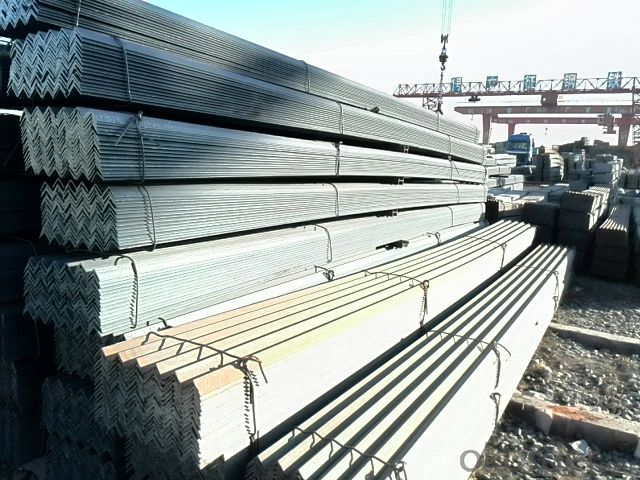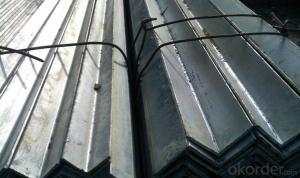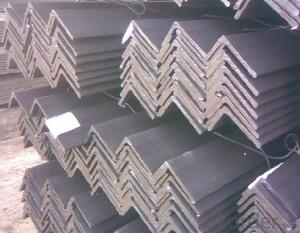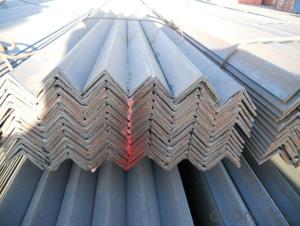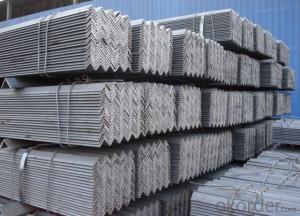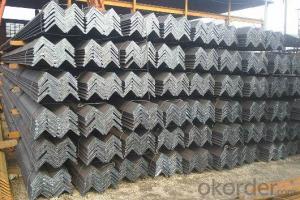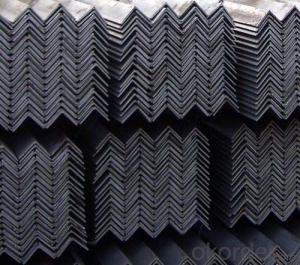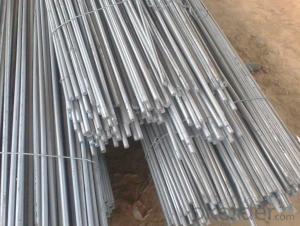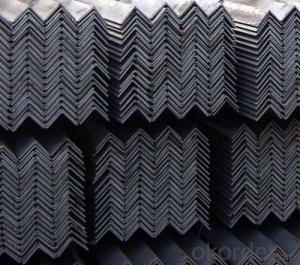Hot Rolled Steel Angle Bars with Size 20x20-200x200
- Loading Port:
- Tianjin
- Payment Terms:
- TT OR LC
- Min Order Qty:
- 25 m.t
- Supply Capability:
- 10000 m.t/month
OKorder Service Pledge
OKorder Financial Service
You Might Also Like
OKorder is offering Hot Rolled Equal Angles at great prices with worldwide shipping. Our supplier is a world-class manufacturer of steel, with our products utilized the world over. OKorder annually supplies products to European, North American and Asian markets. We provide quotations within 24 hours of receiving an inquiry and guarantee competitive prices.
Product Applications:
Hot Rolled Equal Angles are ideal for structural applications and are widely used in the construction of buildings and bridges, and the manufacturing, petrochemical, and transportation industries.
Product Advantages:
OKorder's Hot Rolled Equal Angles are durable, strong, and resist corrosion.
Main Product Features:
· Premium quality
· Prompt delivery & seaworthy packing (30 days after receiving deposit)
· Corrosion resistance
· Can be recycled and reused
· Mill test certification
· Professional Service
· Competitive pricing
Product Specifications:
Manufacture: Hot rolled
Grade: Q195 – 235
Certificates: ISO, SGS, BV, CIQ
Length: 6m – 12m, as per customer request
Packaging: Export packing, nude packing, bundled
Sizes: 25mm-250mm | ||
a*t | ||
25*2.5-4.0 | 70*6.0-9.0 | 130*9.0-15 |
30*2.5-6.6 | 75*6.0-9.0 | 140*10-14 |
36*3.0-5.0 | 80*5.0-10 | 150*10-20 |
38*2.3-6.0 | 90*7.0-10 | 160*10-16 |
40*3.0-5.0 | 100*6.0-12 | 175*12-15 |
45*4.0-6.0 | 110*8.0-10 | 180*12-18 |
50*4.0-6.0 | 120*6.0-15 | 200*14-25 |
60*4.0-8.0 | 125*8.0-14 | 250*25 |
FAQ:
Q1: Why buy Materials & Equipment from OKorder.com?
A1: All products offered byOKorder.com are carefully selected from China's most reliable manufacturing enterprises. Through its ISO certifications, OKorder.com adheres to the highest standards and a commitment to supply chain safety and customer satisfaction.
Q2: What is the normal tolerance of your steel products ?
A2: Normally 7%-9%, but we can also produce the goods according to the customers' requests.
Q3: Can stainless steel rust?
A3: Stainless does not "rust" as you think of regular steel rusting with a red oxide on the surface that flakes off. If you see red rust it is probably due to some iron particles that have contaminated the surface of the stainless steel and it is these iron particles that are rusting. Look at the source of the rusting and see if you can remove it from the surface.
Images:
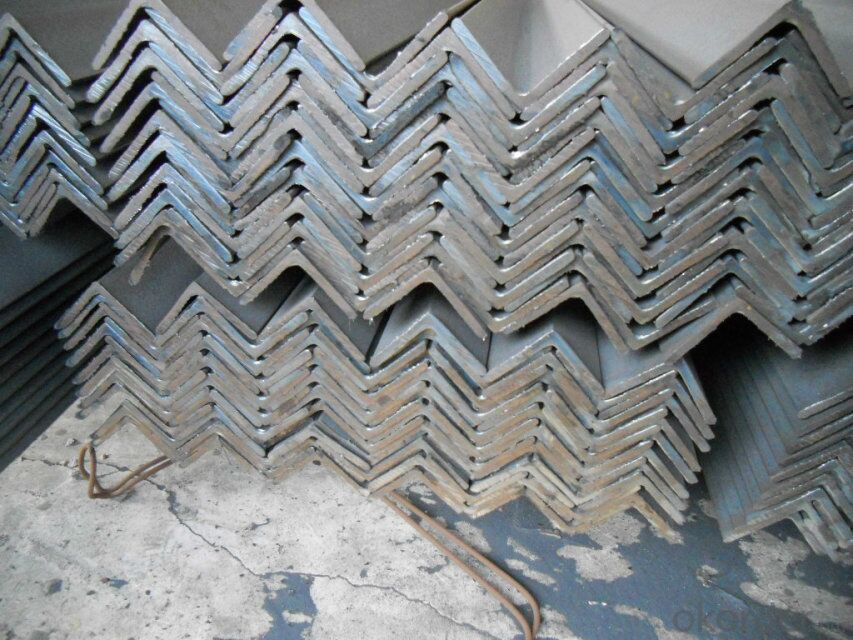
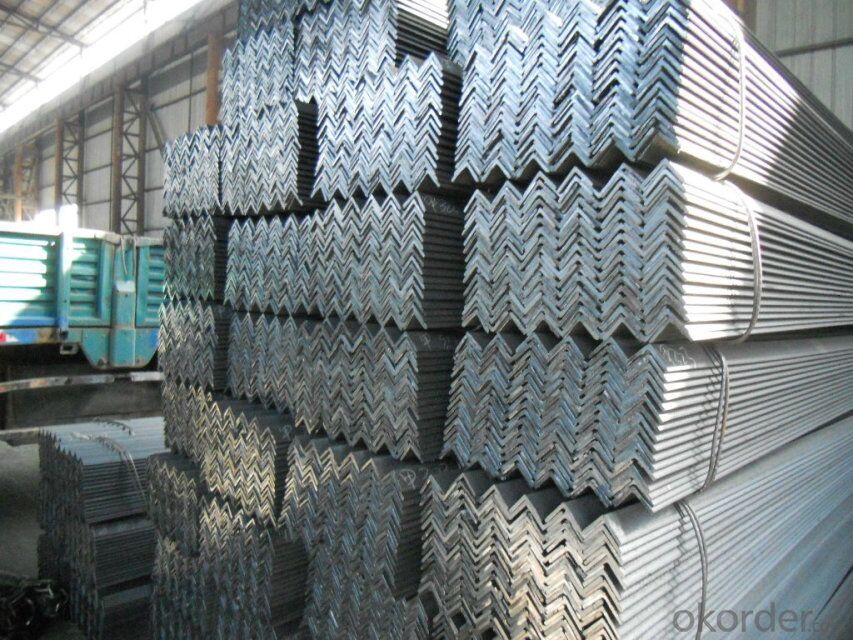
- Q: Can steel angles be used as supports for HVAC systems or ductwork?
- Yes, steel angles can be used as supports for HVAC systems or ductwork. Steel angles provide excellent strength and durability, making them ideal for supporting the weight of HVAC systems and ductwork. They can easily be mounted to walls or ceilings to provide a stable and secure support structure.
- Q: Are steel angles suitable for conveyor systems?
- Indeed, conveyor systems can indeed employ steel angles. The reason for the frequent use of steel angles in conveyor systems lies in their strength, durability, and versatility. Steel angles offer a robust framework capable of bearing hefty loads and enduring the perpetual motion and vibrations inherent in a conveyor system. Assembling the conveyor system's structure becomes a breeze as steel angles can be effortlessly welded or bolted together, granting effortless customization and adaptation. Furthermore, steel angles boast corrosion resistance, rendering them fitting for diverse environments and applications.
- Q: How do steel angles contribute to the overall durability of a structure?
- Steel angles contribute to the overall durability of a structure by providing structural support and reinforcement. They are commonly used in construction to add strength and stability to various components of a building, such as beams, columns, and frames. The L-shaped design of steel angles allows them to effectively distribute and transfer loads, reducing the risk of deformation, collapse, or failure. Additionally, their high tensile strength and resistance to bending and twisting make them ideal for withstanding heavy loads, seismic forces, and adverse environmental conditions, thus enhancing the durability and longevity of the structure.
- Q: How do steel angles compare to wooden beams?
- Steel angles are often preferred over wooden beams due to their superior strength and durability. Steel angles have a higher load-bearing capacity, making them suitable for supporting heavier structures. They are also fire-resistant and less susceptible to warping, rotting, or termite infestation, which are common issues with wooden beams. Additionally, steel angles are more versatile as they can be easily customized and shaped to fit specific construction requirements.
- Q: What are the different methods of surface finishing for steel angles?
- Steel angles can be finished using various methods, each with its own advantages and considerations. Painting, galvanizing, powder coating, and shot blasting are the most commonly used methods. When it comes to surface finishing steel angles, painting is a popular choice. It not only protects against corrosion but also adds an appealing look. Typically, the angle is cleaned and primed before multiple coats of paint are applied. This method allows for a wide range of colors and easy touch-ups in case of damage. Galvanizing, on the other hand, involves coating the steel angle with zinc to safeguard it from corrosion. This method is particularly effective in harsh environments where moisture or chemicals may be present. The most common technique is hot-dip galvanizing, wherein the angle is immersed in molten zinc. This creates a durable finish that requires minimal maintenance. Another widely used method is powder coating, which entails applying a dry powder to the angle and then curing it with heat. This forms a protective layer that offers excellent durability and resistance to corrosion, chemicals, and UV rays. Powder coating also provides a smooth and consistent finish, with a wide array of color options. For a mechanical surface finishing approach, shot blasting is employed. This method involves blasting the steel angle with high-speed abrasive particles to remove rust, mill scale, or other contaminants. It results in a clean and smooth finish while creating a rough texture that enhances paint adhesion. Shot blasting is often used as a pre-treatment before painting or powder coating. When selecting a surface finishing method for steel angles, it is crucial to consider the specific requirements of their application. Factors such as the environment, expected lifespan, aesthetic preferences, and budget should all be taken into account. Seeking guidance from professionals or the steel manufacturer can help determine the most suitable surface finishing method for steel angles in a given situation.
- Q: Can steel angles be used for conveyor supports?
- Conveyor supports can indeed utilize steel angles. These angles find frequent application in industrial settings, such as conveyor systems, where their structural integrity and durability offer exceptional strength and support. By welding or bolting steel angles together, one can effortlessly construct robust and steadfast conveyor frames. Moreover, their adaptability permits tailoring to meet precise design prerequisites. All in all, steel angles prove themselves as dependable and economical options for supporting conveyors.
- Q: How do steel angles contribute to the overall aesthetics of a structure?
- Steel angles can contribute to the overall aesthetics of a structure by adding visual interest and complexity to its design. The clean lines and sharp edges of steel angles can create a modern and industrial look, enhancing the overall aesthetic appeal. Moreover, steel angles can be used to create dynamic and unique architectural features such as cantilevered sections or intricate patterns, adding a sense of creativity and innovation to the structure's appearance.
- Q: How do steel angles contribute to the overall sustainability of a building?
- A building's overall sustainability is enhanced by steel angles in various ways. To begin with, steel angles are constructed from recycled materials, making them a sustainable choice for building purposes. Steel is one of the world's most recycled materials, boasting a high recycling rate. This reduces the necessity for new resources and lessens the environmental impact of extraction and production. Additionally, steel angles offer structural efficiency, enabling them to support greater loads with less material compared to other building materials. This efficiency reduces the amount of steel needed for construction, minimizing the carbon footprint associated with steel production and transportation. Furthermore, steel angles are extremely durable and long-lasting. They possess high resistance to corrosion, fire, and pests, thereby reducing the maintenance and replacement requirements over the building's lifespan. This durability results in reduced waste generation and lower life-cycle costs, ultimately making the building more sustainable in the long term. Moreover, steel angles are versatile and easily reusable or repurposed. In the event of renovation or demolition, salvaging and reusing the steel angles in other construction projects is feasible. This promotes a circular economy approach, minimizing waste generation and contributing to the overall sustainability of the construction industry. Lastly, steel angles possess excellent thermal properties that can enhance a building's energy efficiency. They can be utilized as part of the building envelope, aiding in the reduction of energy consumption for heating and cooling. By improving insulation and airtightness, steel angles contribute to lower energy demand and reduced greenhouse gas emissions. In conclusion, steel angles contribute to a building's overall sustainability through their recycled content, structural efficiency, durability, recyclability, and energy-saving properties. Opting for steel angles in construction allows for resource conservation, waste reduction, and a minimized environmental impact in the built environment.
- Q: How do steel angles contribute to the sustainability of a city?
- Steel angles contribute to the sustainability of a city in various ways. Firstly, they are commonly used in construction, providing structural support and stability to buildings and infrastructure. Due to their high strength-to-weight ratio, steel angles require less material and resources compared to other building materials, reducing the overall environmental impact of construction. Additionally, steel angles are highly durable, corrosion-resistant, and have a long lifespan, reducing the need for frequent replacements or repairs, thus minimizing waste generation. Moreover, steel is a recyclable material, and steel angles can be easily recycled and repurposed, decreasing the demand for new steel production and conserving natural resources. Therefore, the use of steel angles in construction promotes sustainable practices, contributes to the efficient use of resources, and helps create resilient and long-lasting cities.
- Q: What are the benefits of using hot-rolled steel angles?
- Hot-rolled steel angles offer numerous advantages in diverse applications. To begin, their notable strength and durability are well-known. This is achieved through the hot-rolling process, which involves heating the steel above its recrystallization temperature and shaping it accordingly. Consequently, hot-rolled steel angles possess superior strength compared to their cold-rolled counterparts, rendering them ideal for structural applications that require robust load-bearing capacity. Moreover, hot-rolled steel angles exhibit exceptional weldability. The high temperatures endured during the hot-rolling process refine the steel's grain structure, making it easier to weld. This characteristic proves particularly beneficial in construction projects where the seamless joining of steel angles is crucial for creating a variety of structures. In addition, hot-rolled steel angles boast a flawless surface finish. The hot-rolling process effectively eliminates surface defects and impurities, resulting in a clean and polished appearance. This aesthetic appeal makes hot-rolled steel angles suitable for architectural and decorative purposes. Furthermore, hot-rolled steel angles offer cost-effectiveness. The efficiency and affordability of the hot-rolling process surpass those of alternative manufacturing methods, such as cold-rolling. As a result, hot-rolled steel angles are more budget-friendly, providing an advantage for cost-conscious projects. Lastly, hot-rolled steel angles are readily available in an extensive range of sizes and dimensions. This versatility allows for greater flexibility in design and construction applications. Regardless of whether the project is residential, commercial, or industrial in nature, the availability of various sizes ensures that hot-rolled steel angles can be easily incorporated. Overall, the multiple benefits of hot-rolled steel angles encompass their high strength, excellent weldability, smooth surface finish, cost-effectiveness, and availability in diverse sizes. These qualities contribute to the popularity of hot-rolled steel angles across various industries and applications.
Send your message to us
Hot Rolled Steel Angle Bars with Size 20x20-200x200
- Loading Port:
- Tianjin
- Payment Terms:
- TT OR LC
- Min Order Qty:
- 25 m.t
- Supply Capability:
- 10000 m.t/month
OKorder Service Pledge
OKorder Financial Service
Similar products
Hot products
Hot Searches
Related keywords



